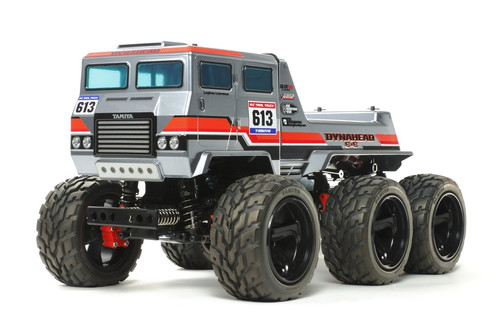Product Overview
Tamiya 35218
The American motor car industry produced an outstanding number of military vehicles during 5 years of the World War 2. Those were widely used not only by the U.S. troops but also by other allied troops. The U.S. was literally the arsenal of democracies.
As the World War 2 was the first modern mobile warfare, logistics was of greater importance than ever. Sometimes, it was even more important to ensure smooth supply lines than to develop better ordnance. Many kinds of vehicle were used for supply operations, and among them, the 2 1/2 ton truck, known as "Jimmy" or "Deuce and a half", was one of the most mass produced vehicles, recording the total production of 810,000. The nickname "Jimmy" was derived because the majority of the total production was done by the GMC firm.
The most widely used engine was Type 270 with a displacement of 4,416cc, yielding 104 horsepower. The power was transmitted to the wheels via five-speed transmission. Two types of driving axles were offered to the truck. One is "Banjo type" manufactured by Chevrolet and the other is "Split type" made by Timkin. Apart from the driving axles, many components, such as cabin, cargo body and chassis frame, varied according to the manufacturers and various uses. Variants included the normal steel-body cargo truck, water tanker, gasoline tanker, cargo-dump truck and multi-role type with tipping cargo body. The most popular variant, GMC CCKW-353 with normal cabin and long wheelbase of 164 inch, weighing 4.8 ton, had carrying capacity of 2.42 ton on rough roads and 4 ton on pavement. The maximum speed reached 72km/h. Having the then first class performance like these, the 2 1/2 trucks ran across all the battle fields as a means of transport for the Allied forces and played an important role to bring about the victory of the Allies.
After its retirement from the U.S. Army in the early 50"s, they were transferred to all over the world and had a great influence on the progress of today"s military motorcars.
Requires paint and assembly.
The American motor car industry produced an outstanding number of military vehicles during 5 years of the World War 2. Those were widely used not only by the U.S. troops but also by other allied troops. The U.S. was literally the arsenal of democracies.
As the World War 2 was the first modern mobile warfare, logistics was of greater importance than ever. Sometimes, it was even more important to ensure smooth supply lines than to develop better ordnance. Many kinds of vehicle were used for supply operations, and among them, the 2 1/2 ton truck, known as "Jimmy" or "Deuce and a half", was one of the most mass produced vehicles, recording the total production of 810,000. The nickname "Jimmy" was derived because the majority of the total production was done by the GMC firm.
The most widely used engine was Type 270 with a displacement of 4,416cc, yielding 104 horsepower. The power was transmitted to the wheels via five-speed transmission. Two types of driving axles were offered to the truck. One is "Banjo type" manufactured by Chevrolet and the other is "Split type" made by Timkin. Apart from the driving axles, many components, such as cabin, cargo body and chassis frame, varied according to the manufacturers and various uses. Variants included the normal steel-body cargo truck, water tanker, gasoline tanker, cargo-dump truck and multi-role type with tipping cargo body. The most popular variant, GMC CCKW-353 with normal cabin and long wheelbase of 164 inch, weighing 4.8 ton, had carrying capacity of 2.42 ton on rough roads and 4 ton on pavement. The maximum speed reached 72km/h. Having the then first class performance like these, the 2 1/2 trucks ran across all the battle fields as a means of transport for the Allied forces and played an important role to bring about the victory of the Allies.
After its retirement from the U.S. Army in the early 50"s, they were transferred to all over the world and had a great influence on the progress of today"s military motorcars.
Requires paint and assembly.







